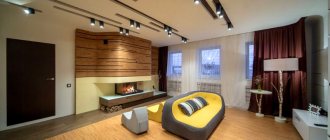Batteries in the interior of an apartment or private house are a necessity. The harsh conditions of our climate require the installation of a high-quality heating system that will ensure comfortable living throughout most of the year. Radiators are difficult to classify as interior decorations. This unsightly part of the communication lines of the heating system spoils many sophisticated interiors. However, radiators can be easily turned into stylish decor with simple manipulations. Let's talk about how to hide batteries in the interior.
The history of radiators
A couple of centuries ago, fireplaces and stoves, which were heated with coal or wood, were responsible for heating the house. In many Russian villages these units are still preserved and are still used for their intended purpose. The first prototype of the heating system is considered to be the Roman hypocausts. They were a set of channels that ran under the floor and connected to the stove. Warming up of the premises occurred due to hot air. Roman baths were heated with water running through copper pipes. The liquid was also heated in the furnace. Thus, in Ancient Rome there were two types of heating systems: steam and water. The ovens themselves were first made of clay, then of stone and brick.
The furnace revolution was carried out by Benjamin Franklin, known largely for his political activities. The inventor used cast iron to make the stove. The metal took a long time to heat up, but also cooled down slowly. The cast iron unit became the prototype of two modern inventions at once: boilers and radiators. The next to show his ingenuity was an English engineer who, based on the Franklin stove, created a complex water heating system for heating a winter garden. The liquid was heated in large volume boilers. The water then entered the pipes, where it circulated, giving off heat, and returned to be reheated. This idea was adopted not only by English engineers, but also by domestic ones.
Similar units were used to heat the Summer Palace in the Peter the Great era. The systems used conventional pipes, which still did not heat the air well due to their small area. The first to come up with a cast iron radiator, which was a system of disks and a pair of thick pipes connected to a boiler, were domestic inventors. Such batteries quickly spread throughout Europe and beyond. However, gravity heating systems eventually replaced units that operated on pumps. In them, the liquid spread along communication lines as a result of forced injection. Closer to the 30s of the last century, tubular radiators came to replace cast iron radiators. After another thirty years, aluminum batteries began to be used. Starting in the 20s, they began to introduce an innovative (at that time) centralized heating system, which is still in use today.
Heating radiators
Heating radiators are a difficult task for both owners and designers. If the heating radiator is usually covered with curtains, then its decor is not so important. But if heating radiators are visible, then you want them to look decent. And some people want them to fit into the interior and look decorative. In this article we will look at examples of the design of heating radiators and screens for radiators.
In the photo on the left you see something beautiful that resembles an abstract painting and fits perfectly with the design of the room. And yet this is just a radiator screen. Click on the photo to view in more detail.
So, the first way to beautifully design radiators is to cover them with a beautiful screen.
When choosing a decorative screen for a radiator, decide what its role will be in the interior. A screen for a heating radiator can look like an independent interior object, as in the photo on the right.
Or maybe it just unobtrusively combines with the entire interior, as in the photo on the left. This decorative screen for a radiator does not attract much attention, but supports the overall interior design.
In both the first case (the screen for the radiator as a noticeable interior object) and the second (the screen as an unobtrusive detail), you will have to look hard. Our market for decorative screens for radiators is still poorly developed, and the choice is small.
But there is a way out. If you have a modern heating radiator, sewn into a thin metal casing, then you can paint (or have an artist paint) this casing itself, and then you will not need a decorative screen.
Important ! Screens for radiators can only be painted with special heat-resistant paints.
And for those who value every calorie of heat and do not want to install a decorative screen, designers are developing stunningly beautiful models of heating radiators.
A heating radiator like the one in the photo on the right will suit an interior in any modern style - but especially in a high-tech style.
photo is clickable
A heating radiator, similar to a subtle pattern, as in the photo on the left, looks very elegant and will suit a stylish, glamorous bedroom interior. Especially if you replace red with white or champagne.
_______________
Speaking of red. Some radiators are painted with a special paint that changes color when heated. The battery is white when cold and red when hot - this is convenient when there are children in the house. True, this is necessary for those who turn the heating on and off in their home themselves, but consumers of central heating seem to have no need for it.
click on the photo to view in more detail
And several more models of designer heating radiators.
The photo is clickable. The first, largest photo shows a fairly ordinary heating radiator, just beautifully curved. On the top right there is a wonderful bow, quite functional and very unusual.
And in the bottom photo on the right - a completely revolutionary idea - the heating radiator is also a chair. It is clear that only those who have a thermostat installed that regulates the temperature of the battery can use it. It would be quite funny to install such a radiator in the hallway - you come tired and cold, sit on the radiator, sit for five minutes - and life seems to get better.
So, we have three main ideas for the design of a heating radiator : 1) a noticeable, impressively painted decorative screen for a heating radiator 2) an inconspicuous decorative screen that supports the overall interior design 3) a designer model of a heating radiator.
I wish you to find yours!
Methods of stylistic decoration
The simplest option for disguising an unsightly radiator that does not fit with the stylistic decision in the design of the room is considered to be a screen. This is most often a ready-made panel with holes that is used to cover the battery. It can be suspended or built into a special box, that is, it can completely hide the radiator. Screens are made of glass, MDF, metal. There are also wooden panels that look like “wicker”. The color of their surface is selected to match the furnishings of the room. Glass is ideal for modern “high-tech” styles. Metal screens are often made with forging elements. Floral motifs will fit in an original way into country or classic style. Radiators can be decorated not only with the help of screens. The simplest, budget-friendly methods include painting. Colored radiators are combined with the shade of curtains, walls, or make the radiator an accent of the interior. Sometimes the unit is covered with strips of wallpaper, thereby completely masking the surface. Black, gray, white radiators are combined with loft, minimalism, high-tech, futurism and avant-garde. Sometimes fabric curtains are used, which are attached to the windowsill. A similar cozy solution in the style of Provence, eclecticism, ethnicity or classic looks appropriate. Using putty, the drawing is given additional volume. Copper radiators are decorated with artificial patina, aging the surface.
In some cases, radiators are skillfully decorated to look like a “fireplace”. On the sides of the battery there are shelves for books and decorations. It’s worth remembering: the deeper the battery is hidden, the more it will affect its performance.
How to choose a radiator for interiors in different styles?
A design radiator, having emerged from the shadows and become a full-fledged decorative element of the environment, must match it in style. For modern interiors, such as loft or hi-tech, choosing an interesting radiator may be easier than for a classic or country one, however, for any style you can choose a suitable bimetallic radiator from the Royal Thermo brand.
Advice: don't be afraid to experiment. An unusual vertical or contrasting black radiator can become an unexpected focal point of the entire interior, replacing a banal poster or photograph on the wall.
How to choose the right one
Radiators are selected according to size, design and material. But their number for a specific room will have to be calculated. To get the correct value, you need to take into account the size of the room, the material from which the frames and the building itself are made, the number of external walls and window openings. Based on these data, the thermal power is calculated.











